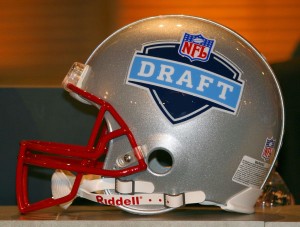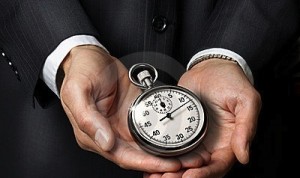 In the week leading up to the NFL Draft, teams really start to get a good feel for which players will be available in the first round around the position of their pick. Before trade talks commence indicating interest in trading positions in the Draft to acquire the player(s) most coveted, teams first try to determine which teams might be good trading partners. Preliminary phone calls are placed regarding an interest in moving up or down and what compensation might be attached to such a move. Hypothetical situations are touched upon without giving away any information. For example, “If our guy is still on the board at your 14th pick and you have no strong interest in any players at that point, what compensation might you want from us to move up from the 21st pick?”
In the week leading up to the NFL Draft, teams really start to get a good feel for which players will be available in the first round around the position of their pick. Before trade talks commence indicating interest in trading positions in the Draft to acquire the player(s) most coveted, teams first try to determine which teams might be good trading partners. Preliminary phone calls are placed regarding an interest in moving up or down and what compensation might be attached to such a move. Hypothetical situations are touched upon without giving away any information. For example, “If our guy is still on the board at your 14th pick and you have no strong interest in any players at that point, what compensation might you want from us to move up from the 21st pick?”
Every pick has a value, decreasing as the Draft progresses and the perceived talent level of the Draft prospects declines. Teams take this into account, but in order to track if a trade is of equal value, a trade chart exists. Trade charts assign a point value to each Draft selection choice number, so when teams talk about trading, they try to get the point totals as close to equal as possible so that both sides get what they want. Sometimes teams are desperate, and if the leverage shifts to one team then obviously the desperate team will give up more. But typically Draft pick point totals are relatively equal, and most teams have trade charts that are very similar.
 Top Secret
Top Secret
Throughout all of these meetings, analyses, mock drafts, discussions, and phone calls, confidentiality is of the utmost of importance. As humans we like to be able to say that we know something that someone else doesn’t know, but if one person leaks information about who their team is targeting in the NFL Draft and another team catches wind of that information, that player is less likely to be available for the team that leaked their secret. Accordingly, team staff members are usually limited to the accessibility to the boards ranking the players and even more limited to partake in executive meetings, especially in the days leading up to the Draft. Most teams even limit what the scouts or coaches have access to during scouting meetings: Executives might simply ask them to present their reports and then leave the Draft room. Even on the days of the Draft, numerous teams limit the team personnel that are allowed into the Draft Room! The only reason I even know what goes on during this Draft preparation process is because I worked in the Draft room all weekend. (I believe team executives recognized my trustworthiness and gave me such an opportunity to observe and learn.)
The final 24 hours before the Draft might have a few phone calls, but it is typically a quiet day of review making sure every piece of information is in place. Minor tweaks are made, but teams just try to make sure they are fully prepared for every scenario and any last minute phone calls.
 Last Minute
Last Minute
The rare exception to a less hectic few days leading up to the Draft is if the team has the first pick in the Draft. In that scenario, a team can choose to sign the player they want to a contract before the Draft even begins. This obviously cements the pick at the time of signing. The advantage is that it eliminates the player potentially holding out or demanding a trade after the selection is made.
However, as negotiations go, agreements are often not reached until the 11th hour… the final moment before adverse consequences exist. In the case of the NFL Draft, this last gasp is the hours leading up to the Draft. This creates a pressurized situation of final contract phone calls back-and-forth, minor adjustments and numerous drafts and versions of the contract flying everywhere. After all, the contract needs to be signed and submitted to the NFL League Office for approval before the NFL Draft starts, or the contract is not official. I was an integral part of such a situation one year with the top overall pick, and lets just say that sleep was at a minimum as I didn’t get much time away from my desk in the 48 hours prior to the start of the Draft. If the contract is not final before the start of the Draft, the team can obviously still select the player, but that player has increased odds of holding out.. If nothing has been finalized after weeks of negotiating, why would a team feel any more confident the player will sign in the weeks to follow? The next 11th hour would become the start of training camp, and no team wants the number one pick in the Draft missing any training camp time.
Regardless of what has transpired leading up to 8:00 pm on the last Thursday of April, teams are fully prepared at that time. They are knowledgeable and ready to make the decisions that will impact their organizations for years to come. But this isn’t just picking sides for a game of backyard football… Rather, they are ready to participate in a pressure-packed game of speed chess with 31 opponents!
 Sitting on Ready
Sitting on Ready
The NFL Draft itself is quite the exhilarating experience! It feels like Christmas Day. The whole organization is excited, ready to celebrate the players selected in the NFL Draft. At this point, everyone in the organization has his or her own idea of the players that should be drafted, but only a few have the authority to actually make the final decisions. After going through the process of reporting and ranking, a plan of action is in place with potential alternate plans in place. Everyone in the Draft room is educated as to how the Draft will progress ideally, but they are also aware of how the Draft will progress realistically. The catch is that NEITHER of these situations will occur. Something unexpected ALWAYS happens.
The Draft Room itself is fully prepped in the days leading up to the Draft. Multiple phones, two or more televisions and numerous laptops are added to the existing tables, chairs and desks. Information needs to flow as quickly as possible without any unnecessary interruption or distraction. The phones are necessary for multiple trade conversations, the televisions to track announcements and prospects talking on their phones in New York City, and computers for emails and tracking the NFL Draft electronically. Everyone has their smart phone as well for communication.
Every team has a different number of Front Office members in the Draft Room, but everyone in the room has importance. Every member of the organization that adds information or value to this process is present at the facility leading up to and during the Draft. They may not all be in the Draft Room, but they are readily accessible. In addition to the presence of ownership, there need to be people assigned to answer trade phone calls, make trade phone calls, review trades according to the trade value chart, communicate to team representatives in New York City, provide final medical clarification, review scouting reports, answer questions about other team’s rosters, move magnetic player cards around the boards, call the player the team is going to select, and offer final clarification on the player’s value to the team. When a team’s pick is approaching, activity really starts to pick up, and these people are necessary to perform perfectly in a short time window.
Each team also sends 2 representatives to New York City where the NFL League Office announces the Draft selections, but these representatives simply write down the names of the players their team wants and submit the names to the podium. Teams might send equipment staff, finance managers, trainers, or community affairs staff, but whomever they send, these representatives maintain communication continuously via a secured phone line to their team’s Draft Room. When a team is ready to select a player, they relay the names over the phone to these representatives in New York who write the name on an official card and submit it to the NFL League Office to be announced at the podium. As sophisticated as the event in New York City looks, it is simply an announcing and recording location for teams: All of the critical team decisions are happening at team headquarters across the nation.
 With the First Pick…
With the First Pick…
Excitement abounds as the Commissioner first steps to the podium. Everyone wants to see how the Draft will unfold. As players are selected and team Draft boards (the walls with the player cards) are updated, each team gets a feel for how accurate their mock scenarios were and if the players they covet will still be available as anticipated.
Teams meticulously track the progress of the Draft and constantly update their respective Draft strategies. As players are selected, the names are moved on the boards, and teams can clearly see which players are still available and how these players are valued/graded. The team executive(s) with authority in the Draft room ensure that every piece of information is considered and might even call for a last minute consult. The Offensive Coordinator may be called into the room to discuss how exactly he plans to use a player in the Flex package, or the Head Trainer may be called in to detail just how far along a player is with his ACL rehabilitation. Typically these conversations are held just to reinforce the ranking order already established on the board, but the talks can become more valuable later in the Draft because players lower on the board have less comprehensive profiles.
Check back next Friday as I go into detail about the timing, actions and strategies surrounding a team’s pick! I can also be contacted directly with questions or comments.



I need to to thank you for this great read!!
I certainly loved every bit of it. I’ve got you book-marked to check out new stuff you
post…
This is a really good tip particularly to those new to the blogosphere.
Short but very precise information… Many thanks for sharing this
one. A must read post!